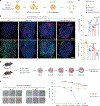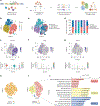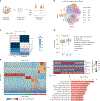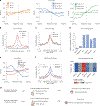Symmetric inheritance of parental histones contributes to safeguarding the fate of mouse embryonic stem cells during differentiation
- PMID: 37666989
- PMCID: PMC10777717
- DOI: 10.1038/s41588-023-01477-w
Symmetric inheritance of parental histones contributes to safeguarding the fate of mouse embryonic stem cells during differentiation
Abstract
Parental histones, the carriers of posttranslational modifications, are deposited evenly onto the replicating DNA of sister chromatids in a process dependent on the Mcm2 subunit of DNA helicase and the Pole3 subunit of leading-strand DNA polymerase. The biological significance of parental histone propagation remains unclear. Here we show that Mcm2-mutated or Pole3-deleted mouse embryonic stem cells (ESCs) display aberrant histone landscapes and impaired neural differentiation. Mutation of the Mcm2 histone-binding domain causes defects in pre-implantation development and embryonic lethality. ESCs with biased parental histone transfer exhibit increased epigenetic heterogeneity, showing altered histone variant H3.3 and H3K27me3 patterning at genomic sites regulating differentiation genes. Our results indicate that the lagging strand pattern of H3.3 leads to the redistribution of H3K27me3 in Mcm2-2A ESCs. We demonstrate that symmetric parental histone deposition to sister chromatids contributes to cellular differentiation and development.
© 2023. The Author(s), under exclusive licence to Springer Nature America, Inc.
Conflict of interest statement
Competing interests
The authors declare no competing interests.
Figures







Comment in
-
Asymmetric inheritance of parental histones leads to differentiation defects in mouse embryonic stem cells.Innov Life. 2024 Mar 8;2(1):100047. doi: 10.59717/j.xinn-life.2024.100047. Epub 2024 Jan 9. Innov Life. 2024. PMID: 38601056 Free PMC article. No abstract available.
Similar articles
-
Disabling leading and lagging strand histone transmission results in parental histones loss and reduced cell plasticity and viability.Sci Adv. 2025 Feb 21;11(8):eadr1453. doi: 10.1126/sciadv.adr1453. Epub 2025 Feb 19. Sci Adv. 2025. PMID: 39970210 Free PMC article.
-
Impaired histone inheritance promotes tumor progression.Nat Commun. 2023 Jun 10;14(1):3429. doi: 10.1038/s41467-023-39185-y. Nat Commun. 2023. PMID: 37301892 Free PMC article.
-
MCM2 promotes symmetric inheritance of modified histones during DNA replication.Science. 2018 Sep 28;361(6409):1389-1392. doi: 10.1126/science.aau0294. Epub 2018 Aug 16. Science. 2018. PMID: 30115746
-
The Role of the MCM2-7 Helicase Subunit MCM2 in Epigenetic Inheritance.Biology (Basel). 2024 Jul 29;13(8):572. doi: 10.3390/biology13080572. Biology (Basel). 2024. PMID: 39194510 Free PMC article. Review.
-
JMJD3: a critical epigenetic regulator in stem cell fate.Cell Commun Signal. 2021 Jul 3;19(1):72. doi: 10.1186/s12964-021-00753-8. Cell Commun Signal. 2021. PMID: 34217316 Free PMC article. Review.
Cited by
-
Replication-coupled inheritance of chromatin states.Cell Insight. 2024 Aug 23;3(6):100195. doi: 10.1016/j.cellin.2024.100195. eCollection 2024 Dec. Cell Insight. 2024. PMID: 39391004 Free PMC article. Review.
-
Always on the Move: Overview on Chromatin Dynamics within Nuclear Processes.Biochemistry. 2025 May 20;64(10):2138-2153. doi: 10.1021/acs.biochem.5c00114. Epub 2025 May 1. Biochemistry. 2025. PMID: 40312022 Free PMC article. Review.
-
The fork protection complex promotes parental histone recycling and epigenetic memory.Cell. 2024 Sep 5;187(18):5029-5047.e21. doi: 10.1016/j.cell.2024.07.017. Epub 2024 Aug 1. Cell. 2024. PMID: 39094569 Free PMC article.
-
Disabling leading and lagging strand histone transmission results in parental histones loss and reduced cell plasticity and viability.Sci Adv. 2025 Feb 21;11(8):eadr1453. doi: 10.1126/sciadv.adr1453. Epub 2025 Feb 19. Sci Adv. 2025. PMID: 39970210 Free PMC article.
-
The molecular basis of cell memory in mammals: The epigenetic cycle.Sci Adv. 2024 Mar;10(9):eadl3188. doi: 10.1126/sciadv.adl3188. Epub 2024 Feb 28. Sci Adv. 2024. PMID: 38416817 Free PMC article. Review.
References
-
- Stillman B Histone modifications: insights into their influence on gene expression. Cell 175, 6–9 (2018). - PubMed
Publication types
MeSH terms
Substances
Grants and funding
LinkOut - more resources
Full Text Sources
Molecular Biology Databases
Miscellaneous

